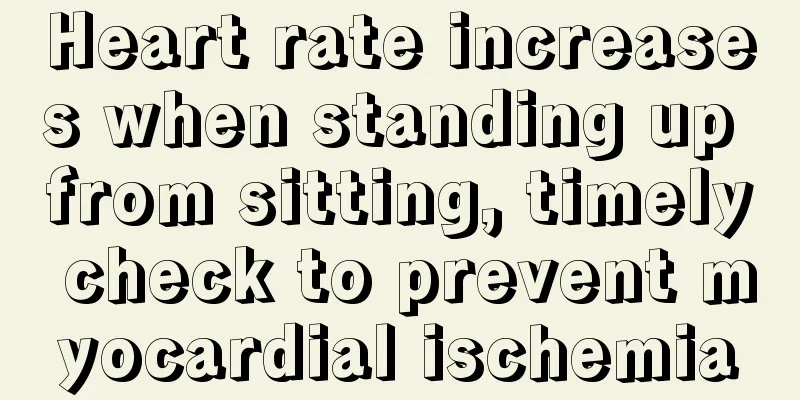Heart rate increases when standing up from sitting, timely check to prevent myocardial ischemia

|
When our heart rate increases when we stand up from sitting, the most common possibility is myocardial ischemia. The incidence of myocardial ischemia is high among middle-aged and elderly people. Especially now that our living standards are high, myocardial ischemia is more likely to occur. If related symptoms occur, you should seek medical attention in time. 1. Symptoms of myocardial ischemia (1) When tired or mentally stressed, dull pain or tightening pain may occur behind the sternum or in front of the heart, radiating to the left shoulder and left upper arm, lasting for 3-5 minutes, and relieved on its own after rest, sometimes accompanied by profuse sweating. (2) Those who experience chest tightness, palpitations, and shortness of breath during physical activity and whose symptoms are relieved by rest. (3) Exercise-related sore throat, burning sensation, tightness, toothache, etc. (4) People who experience chest pain or tightness after a full meal, exposure to cold or drinking alcohol. (5) People who feel chest tightness and shortness of breath when sleeping with a low pillow at night and need to lie with a high pillow to feel comfortable; people who suddenly experience chest pain, palpitations, or difficulty breathing when sleeping soundly or lying flat during the day and need to sit up or stand up immediately to feel relieved. (6) Palpitations, chest tightness, shortness of breath, or chest pain during sexual intercourse or straining to defecate. (7) Sudden bradycardia, hypotension or syncope. 2. Inspection 1. Examination of risk factors related to coronary heart disease. In order to detect myocardial ischemia as early as possible, people over 40 years old should undergo regular physical examinations to understand whether they have risk factors related to coronary heart disease, such as blood lipids, blood pressure, blood sugar, neck vascular ultrasound, cardiac ultrasound, electrocardiogram and other examinations. 2. Check under load test. If you are at high risk of myocardial ischemia, you should ask your doctor whether you have typical symptoms of coronary heart disease and decide whether you need to undergo stress tests, such as treadmill electrocardiogram, adenosine stress echocardiogram, and multi-slice coronary CT. 3. Coronary angiography. Through non-invasive evaluation, it is determined whether further diagnosis using coronary angiography, the gold standard for diagnosing coronary heart disease, is needed to clarify the extent and range of coronary artery lesions. |
<<: What is the appropriate SPF?
>>: Anal bleeding, what's going on?
Recommend
Our stomach has “ten fears”, those who don’t know deserve to have stomach problems
There are many people who have stomach problems i...
What are the causes of thyroid cancer? Is the main cause of thyroid cancer hereditary?
There are many reasons for the occurrence of thyr...
What is the reason for general weakness and sweating
Due to the high work pressure of people nowadays,...
Will cold body cause acne
In fact, there are more and more people with cold...
Can small ears be enlarged?
Many people don't actually pay much attention...
What should I do if my hand hurts after touching a chili pepper?
Chili pepper is the most common ingredient in our...
What measures are taken for the diagnosis of nasopharyngeal carcinoma
Cancer is very common in life. Many people do not...
What should I do if I get bit by a centipede
People are usually bitten by centipedes in the su...
What is the reason for heavy calves
If you usually feel that your calves are heavy, i...
How to clean clothes stained with ink
For friends who are learning to practice pen or b...
How to make red bean bread in the oven
Many children like to eat red bean bread, which i...
What are the hazards and complications of cervical spondylosis?
Cervical spondylosis is an extremely serious dise...
Is femoral head replacement a major surgery?
Femoral head necrosis is a very serious matter fo...
Nasolabial fold malignant tumor, TCM treatment method
Malignant tumor of the nasolabial fold is a commo...
What are the methods to enhance sexual function?
As a man, of course, he hopes that his sexual fun...









